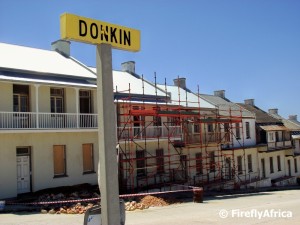|
When the first Settlers arrived in Algoa Bay they found an array of hills, streams, rivers and kloofs, making habitation of the area a problem. Donkin Street as it stands today was originally a “kloof” (steep valley) with a stream. The water it carried was channelled into the then Main Street. This kloof was eventually filled using convict labour and Donkin Street was established in 1851. The row of 18 terraced houses was built in the 1850’s. Over the last few years the houses have deteriorated quite badly under their current owner so it was good to see that renovations started on them recently. It does seem that some changes are being made to some of the original features during the renovations, but I’m just glad to see them being fixed up.
|
Donkin Street houses renovation
This Post Has 3 Comments
Comments are closed.


Looks like they could be made into nice housing if they haven't deteriorated to bad over time.What does Donkin mean?
Donkin street was named after one of the original settlers who landed in Port Elizabeth; Rufane Donkin. The Elizabeth Donkin is a historical landmark holding a light house and a pyramid which is located across the street from these houses. Donkin named the lighthouse the Elizabeth Donkin after his wife who had previously died in India before he came to what is now Poet Elizabeth.
On track but not quite accurate. Donkin Street was named after Sir Rufane Donkin, but he wasn't a settler. Sir Rufane Donkin was the acting governor of the Cape Colony at the time of the arrival of the 1820 British Settlers and he came to Algoa Bay to welcome them to the colony. Donkin declared the area on the hill an open space and that open space is now known as the Donkin Reserve. Donkin had the pyramid on the reserve built as a monument to his wife and the pyramid is known as the Donkin Memorial. The lighthouse wasn't named by Donkin as it was only built in 1861. Although the lighthouse is often referred to as the Donkin Lighthouse, its actual name is The Hill Lighthouse.